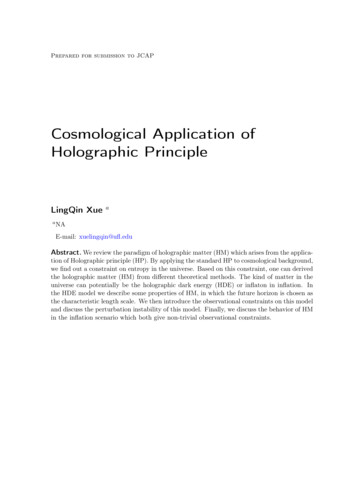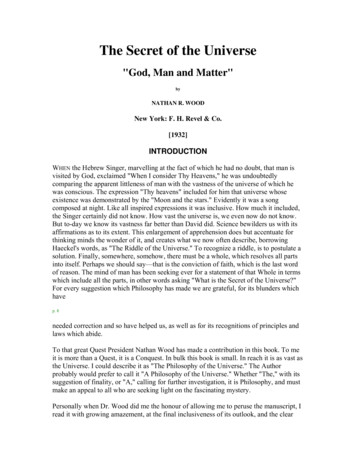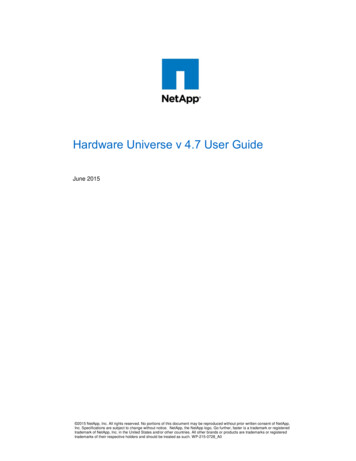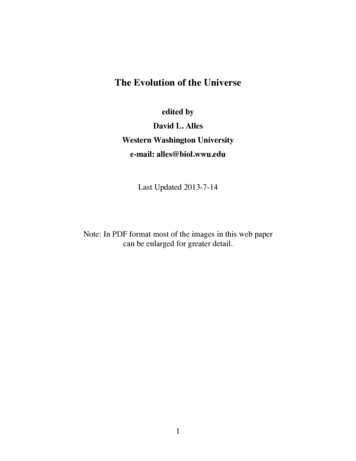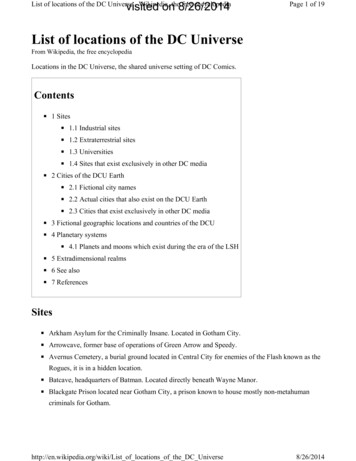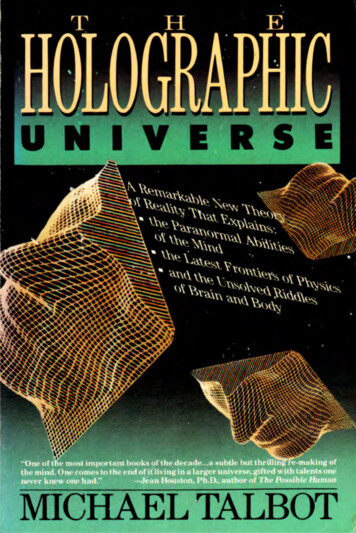
Transcription
THE HOLOGRAPHIC UNIVERSE
HOLOGRAPHICUNIVERSEMICHAEL TALBOT r HarperPerennialA Division of HarperCollinsPublishers
A hardcover edition of this book was published in 1991 by HarperCollinsPublishers.Copyright 1991 by Michael Talbot. Allrights reserved. Printed in the United States of America. No part of thisbook may be used or reproduced in any manner whatsoever without writtenpermission except in the case of brief quotations embodied in critical articles and reviews. For information address HarperCollins Publishers, Inc.,10 East 53rd Street, New York, NY 10022.THE HOLOGRAPHIC UNIVERSE.HarperCollins books may be purchased for educational, business, or salespromotional use. For information, please call or write: Special MarketsDepartment, HarperCollins Publishers, Inc., 10 East 53rd Street, NewYork, NY 10022. Telephone: (212) 207-7528; Fax: (212) 207-7222.First Harper Perennial edition published 1992.Designed by Helene BerinskyLIBRARY OF CONGRESS CATALOG CARD NUMBERISBN0-06-092258-397 98RRD (H) 20 19 1890-55555
For Alexandra, Chad, Ryan,Larry Joe, and Shawn,with love
The new data are of such far-reaching relevance thatthey could revolutionize our understanding of thehuman psyche, of psychopathology, and of the therapeutic process. Some of the observations transcendin their significance the framework of psychologyand psychiatry and represent a serious challenge tothe current Newtonian-Cartesian paradigm of Western science. They could change drastically our imageof human nature, of culture and history, and of real·ity.-Dr. Stanislav Grof onholographic phenomena inThe Adventure of Self-Discovery
ContentsxiAcknowledgmentsIntroduction1PART 1: A REMARKABLE NEW VIEW OF REALITY1 The Brain as Hologram2 The Cosmos as Hologram1132PART II: MIND AND BODY3 The Holographic Model and Psychology4 I Sing the Body Holographic5 A Pocketful of Miracles6 Seeing Holographically5982119162PART Ill: SPACE AND TIME7 Time Out of Mind1978 Traveling in the Superhologram9 Return to the Dreamtime229NotesIndex303329286
AcknowledgmentsWriting is always a collaborative effort and many people have contributed to the production of this book in various ways. It is not possibleto name them all, but a few who deserve special mention include:David Bohm, Ph.D., and Karl Pribram, Ph.D., who were generouswith both their time and their ideas, and without whose work this bookwould not have been written.Barbara Brennan, M.S., Larry Dossey, M.D, Brenda Dunne, Ph.D.,Elizabeth W. Fenske, Ph.D., Gordon Globus, Jim Gordon, StanislavGrof, M.D., Francine Howland, M.D., Valerie Hunt, Ph.D., RobertJahn, Ph.D., Ronald Wong Jue, Ph.D., Mary Orser, F. David Peat,Ph.D., Elizabeth Rauscher, Ph.D., Beatrice Rich, Peter M. Rojcewièz,Ph.D., Abner Shimony, Ph.D., Bernie S. Siegel, M.D., T.M. Srinivasan,M.D., Whitley Strieber, Russell Targ, William A. Tiller, Ph.D., Montague Ullman, M.D., Lyall Watson, Ph.D., Joel L. Whitton, M.D.,Ph.D., Fred Alan Wolf, Ph.D., and Richard Zarro, who were also allgenerous with their time and ideas.Carol Ann Dryer, for her friendship, insight, and support, and forunending generosity when it comes to sharing her profound talent.Kenneth Ring, Ph.D., for hours of fascinating conversation and forintroducing me to the writings of Henry Corbin.Stanley Krippner, Ph.D., for taking the time to call me or drop mea note whenever he came across any new leads on the holographic idea.Terry Oleson, Ph.D., for his time and for kindly allowing me to usehis diagram of the "little man in the ear."Michael Grosso, Ph.D., for thought-provoking conversation andfor helping me track down several obscure reference works onmiracles.Brendan O'Regan of the Institute of Noetic Sciences, for his imporxi
The Cosmos as Hologram1 33State College, for it was there that he first became fascinated byquantum physics.It is an easy fascination to understand. The strange new land thatphysicists had found lurking in the heart of the atom contained thingsmore wondrous than anything Cortés or Marco Polo ever encountered.What made this new world so intriguing was that everything about itappeared to be so contrary to common sense. It seemed more like aland ruled by sorcery than an extension of the natural world, anAlice-in-Wonderland realm in which mystifying forces were the normand everything logical had been turned on its ear.One startling discovery made by quantum physicists was that if youbreak matter into smaller and smaller pieces you eventually reach apoint where those pieces—electrons, protons, and so on—no longerpossess the traits of objects. For example, most of us tend to think ofan electron as a tiny sphere or a BB whizzing around, but nothingcould be further from the truth. Although an electron can sometimesbehave as if it were a compact little particle, physicists have found thatit literally possesses no dimension. This is difficult for most of us toimagine because everything at our own level of existence possessesdimension. And yet if you try to measure the width of an electron, youwill discover it's an impossible task. An electron is simply not an objectas we know it.Another discovery physicists made is that an electron can manifestas either a particle or a wave. If you shoot an electron at the screenof a television that's been turned off, a tiny point of light will appearwhen it strikes the phosphorescent chemicals that coat the glass. Thesingle point of impact the electron leaves on the screen clearly revealsthe particlelike side of its nature.But this is not the only form the electron can assume. It can alsodissolve into a blurry cloud of energy and behave as if it were a wavespread out over space. When an electron manifests as a wave it cando things no particle can. If it is fired at a barrier in which two slitshave been cut, it can go through both slits simultaneously. Whenwavelike electrons collide with each other they even create interference patterns. The electron, like some shapeshifter out of folklore, canmanifest as either a particle or a wave.This chameleonlike ability is common to all subatomic particles. Itis also common to all things once thought to manifest exclusively aswaves Light, gamma rays, radio waves, X rays—all can change fromwaves to particles and back again. Today physicists believe that sub-
The Holographic Model and Psychology73elusion on the fact that such changes take place no matter what technique or psychoanalytic approach the therapist uses. Hence, he feelsall psychoanalytic approaches are purely ceremonial, and change isdue to something else entirely.Levenson believes that something is resonance. A therapist alwaysknows when therapy is going well, he observes. There is a strongfeeling that the pieces of an elusive pattern are all about to cometogether. The therapist is not saying anything new to the patient, butinstead seems to be resonating with something the patient alreadyunconsciously knows: "It is as though a huge, three-dimensional, spatially coded representation of the patient's experience develops in thetherapy, running through every aspect of his life, his history and hisparticipation with the therapist. At some point there is a kind of 'overload' and everything falls into place."19Levenson believes these three-dimensional representations of experience are holograms buried deep in the patient's psyche, and a resonance of feeling between the therapist and patient causes them toemerge in a process similar to the way a laser of a certain frequencycauses an image made with a laser of the same frequency to emergefrom a multiple image hologram. "The holographic model suggests aradically new paradigm which might give us a fresh way of perceivingand connecting clinical phenomena which have always been known tobe important, but were relegated to the 'art' of psychotherapy," saysLevenson. "It offers a possible theoretical template for change and apractical hope of clarifying psychotherapeutic technique.1120Psychiatrist David Shainberg, associate dean of the PostgraduatePsychoanalytic Program at the William Alanson White Institute ofPsychiatry in New York, feels Bohm's assertion that thoughts are likevortices in a river should be taken literally and explains why ourattitudes and beliefs sometimes become fixed and resistant to change.Studies have shown that vortices are often remarkably stable. TheGreat Red Spot of Jupiter, a giant vortex of gas over 25,000 mileswide, has remained intact since it was first discovered 300 years ago.Shainberg believes this same tendency toward stability is what causescertain vortices of thought (our ideas, and opinions) to become occasionally cemented in our consciousness.He feels the virtual permanence of some vortices is often detrimental to our growth as human beings. A particularly powerful vortex candominate our behavior and inhibit our ability to assimilate new ideasand information. It can cause us to become repetitious, create block-
I Sing the Body Holographic115patient was draped in a sheet to conceal any visible problems. Then anacupuncturist with no knowledge of the results examined only theirears. When the results were tallied it was discovered that the earexaminations were in agreement with the established medical diagnoses 75.2 percent of the time.72Ear examinations can also reveal problems with the bones and internal organs. Once when Oleson was out boating with an acquaintancehe noticed an abnormally flaky patch of skin in one of the man's ears.From his research Oleson knew the spot corresponded to the heart,and he suggested to the man that he might want to get his heartchecked. The man went to his doctor the next day and discovered hehad a cardiac problem which required immediate open-heart surgery.73Oleson also uses electrical stimulation of the acupuncture points inthe ear to treat chronic pain, weight problems, hearing loss, and virtually all kinds of addiction. In one study of 14 narcotic-addicted individuals, Oleson and his colleagues used ear acupuncture to eliminate thedrug requirements of 12 of them in an average of 5 days and with onlyminimal withdrawal symptoms.74 Indeed, ear acupuncture has provedso successful in bringing about rapid narcotic detoxification that clinics in both Los Angeles and New York are now using the techniqueto treat street addicts.Why would the acupuncture points in the ear be aligned in the shapeof a miniature human? Oleson believes it is because of the holographicnature of the mind and body. Just as every portion of a hologramcontains the image of the whole, every portion of the body may alsocontain the image of the whole. "The ear holograph is, logically, connected to the brain holograph which itself is connected to the wholebody," he states. "The way we use the ear to affect the rest of the bodyis by working through the brain holograph.1175Oleson believes there are probably acupuncture microsystems inother parts of the body as well. Dr. Ralph Alan Dale, the director ofthe Acupuncture Education Center in North Miami Beach, Florida,agrees. After spending the last two decades tracking down clinical andresearch data from China, Japan, and Germany, he has accumulatedevidence of eighteen different microacupuncture holograms in thebody, including ones in the hands, feet, arms, neck, tongue, and eventhe gums. Like Oleson, Dale feels these microsystems are "holographic reiterations of the gross anatomy," and believes there are stillother such systems waiting to be discovered. In a notion reminiscentof Bohm's assertion that every electron in some way contains the
A Pocketful of Miracles157What Does It All Mean?This incident raises many questions for which I have no answers. I donot know who the people were who threw the umbrella at our feet, orif they were even aware of the magical transformation that took placeas they strolled away, although the woman's bizarre and seeminglypurposeful performance suggests that they were not completely unwitting. Both my professor and I were so transfixed by the magicaltransformation of the umbrella that by the time we had the presenceof mind to ask them, they were long gone. I do not know why the eventhappened, save that it seems obvious it was connected in some way toour talk about Castaneda encountering a similar occurrence.I do not even know why I have had the privilege of experiencing somany paranormal occurrences, save that it appears to be related to thefact that I was born with a great deal of native psychic ability. As anadolescent I started having vivid and detailed dreams about eventsthat would later happen. I often knew things about people I had noright knowing. When I was seventeen I spontaneously developed theability to see an energy field, or "aura," around living things, and tothis day can often determine things about a person's health by thepattern and colors of the mist of light that I see surrounding them.Above and beyond that, all I can say is that we are all gifted withdifferent aptitudes and qualities. Some of us are natural artists. Somedancers. I seem to have been born with the chemistry necessary totrigger shifts in reality, to catalyze somehow the forces required toprecipitate paranormal events. I am grateful for this capacity becauseit has taught me a great deal about the universe, but I do not knowwhy I have it.What I do know is that the "umbrella incident," as I have come tocall it, entailed a radical alteration in the world. In this chapter we havelooked at miracles that have involved increasingly greater shifts inreality. PK is easier for us to fathom than the ability to pluck an objectout of the air, and the materialization of an object is easier for mostof us to accept than the appearance and disappearance of an entiregrove of trees, or the paranormal appearance of a group of peoplecapable of transmogrifying matter from one form into another. Moreand more these incidents suggest that reality is, in a very real sense,a hologram, a construct.The question becomes, Is it a hologram that is relatively stable for
Time Out of Mind199seemed inaccurate, but later proved correct. He said that Stone Agepeoples used oil lamps and was vindicated when excavations in Dordogne, France, uncovered oils lamps of the exact size and style hedescribed. He made detailed drawings of the animals various peopleshunted, the style of the huts in which they lived, and their burialcustoms—assertions that were all later confirmed by archaeologicaldiscoveries.'Poniatowski's work with Ossowiecki is not unique. Norman Emerson, a professor of anthropology at the University of Toronto andfounding vice president of the Canadian Archaeological Association,has also investigated the use of clairvoyants in archaeological work.Emerson's research has centered around a truck driver named GeorgeMcMullen. Like Ossowiecki, McMullen has the ability to psychometrize objects and use them to tune into scenes from the past. McMullencan also tune into the past simply by visiting an archaeological site.Once there, he paces back and forth until he gets his bearings. Thenhe begins to describe the people and culture that once flourished at thesite. On one such occasion Emerson watched as McMullen boundedover a patch of bare ground, pacing out what he said was the locationof an Iroquois longhouse. Emerson marked the area with survey pigsand six months later uncovered the ancient structure exactly whereMcMullen said it would be.2Although Emerson began as a skeptic, his work with McMullen hasmade him a believer. In 1973, at an annual conference of Canada'sleading archaeologists, he stated, "It is my conviction that I havereceived knowledge about archaeological artifacts and archaeologicalsites from a psychic informant who relates this information to mewithout any evidence of the conscious use of reasoning." He concludedhis talk by saying that he felt McMullen's demonstrations opened 'awhole new vista" in archaeology, and research into the further use ofpsychics in archaeological investigations should be given "first priority."3'Indeed, retrocognition, or the ability of certain individuals to shiftthe focus of their attention and literally gaze back into the past, hasbeen confirmed repeatedly by researchers. In a series of experimentsconducted in the 1960s, W. H. C. Tenhaeff, the director of the Parapsychological Institute of the State University of Utrecht, and MariusValkhoff, dean of the faculty of arts at the University of Witwatersrand, Johannesburg, South Africa, found that the great Dutch psychic, Gerard Croiset, could psychometrize even the smallest fragment
Traveling in the Superhologram241It should be noted this is only a general description and not all NDEscontain all of the elements described. Some may lack some of theabove-mentioned features, and others may contain additional ingredients. The symbolic trappings of the experiences can also vary. Forexample, although NDEers in Western cultures tend to enter therealm of the afterlife by passing through a tunnel, experiencers fromother cultures might- walk down a road or pass over a body of waterto arrive in the world beyond.Nevertheless, there is an astonishing degree of agreement amongthe NDEs reported by various cultures throughout history. For instance, the life review, a feature that crops up again and again inmodern-day NDEs, is also described in the Tibetan Book of the Dead,the Egyptian Book of the Dead, in Plato's account of what Er experienced during his sojourn in the hereafter, and in the 2,000-year-oldyogic writings of the Indian sage Patanjali. The cross-cultural similarities between NDEs has also been confirmed in formal study. In 1977,Osis and Haraldsson compared nearly nine hundred deathbed visionsreported by patients to doctors and other medical personnel in bothIndia and the United States and found that although there were various cultural differences—for example, Americans tended to view thebeing of light as a Christian religious personage and Indians perceivedit to be a Hindu one—the "core" of the experience was substantiallythe same and resembled the NDEs described by Moody and KublerRoss.27Although the orthodox view of NDEs is that they are just hallucinations, there is substantial evidence that this is not the case. As withOBEs, when NDEers are out-of-body, they are able to report detailsthey have no normal sensory means of knowing. For example, Moodyreports a case in which a woman left her body during surgery, floatedinto the waiting room, and saw that her daughter was wearing mismatched plaids. As it turned out, the maid had dressed the little girlso hastily she had not noticed the error and was astounded when themother, who did not physically see the little girl that day, commentedon the fact.28 In another case, after leaving her body, a female NDEerwent to the hospital lobby and overheard her brother-in-law tell afriend that it looked like he was going to have to cancel a business tripand instead be one of his sister-in-law's pallbearers. After the womanrecovered, she reprimanded her astonished brother-in-law for writingher off so quickly.29And these are not even the most extraordinary examples of sensory
Traveling in the Superhologram283and institutions of learning, our minds may also be sculpting theoutward appearance of the UFO phenomenon.It is interesting to note that if this is the case, it means that the truereality of these beings is apparently so transmundane and strangethat we have to plumb the deepest regions of our folk memories andmythological unconscious to find the necessary symbols to give themform. It also means that we must be exceedingly careful in interpreting their actions. For example, the medical examinations that are thecenterpiece of so many UFO abductions may be only a symbolic representation of what is going on. Rather than probing our physical bodies,these nonphysical intelligences actually may be probing some portionof us for which we currently have no labels, perhaps the subtle anatomy of our energy selves or even our very souls. Such are the problems one faces if the phenomenon is indeed an omnijective manifestation of a nonhuman intelligence.On the other hand, if it is possible for the faith of the citizens ofKnock and Zeitoun to cause luminous images of the Virgin to coalesceinto existence, for the minds of physicists to dabble around with thereality of the neutrino, and for yogis such as Sai Baba to materializephysical objects out of thin air, it only stands to reason that we wouldalso find ourselves awash with holographic projections of our beliefsand mythologies. At least some anomalous experiences may fall intothis category.For instance, history tells us that Constantine and his soldiers sawan enormous flaming cross in the sky, a phenomenon that seems to benothing more than a psychic exteriorization of the emotions the armyresponsible for nothing short of the Christianization of the paganworld was feeling on the eve of their historic undertaking. The wellknown manifestation of the Angels of Mons, in which hundreds ofWorld War I British soldiers saw an immense apparition of SaintGeorge and a squadron of angels in the sky while fighting what wasat first a losing battle at the front, in Mons, Belgium, also appears tofall into the category of psychic projection.It is clear to me that what we are calling UFO and other folkloricexperiences are really a wide range of phenomena and probably include all of the above. I have also long been of the opinion that thesetwo explanations are not mutually exclusive. It may be that Constantine's flaming cross was also a manifestation of an extradimensionalintelligence. In other words, when our collective beliefs and emotionsbecome high-pitched enough to create a psychic projection, perhaps
3 The Holographic Model and Psychology 4 I Sing the Body Holographic 5 A Pocketful of Miracles 6 Seeing Holographically PART Ill: SPACE AND TIME 7 Time Out of Mind 8 Traveling in the
